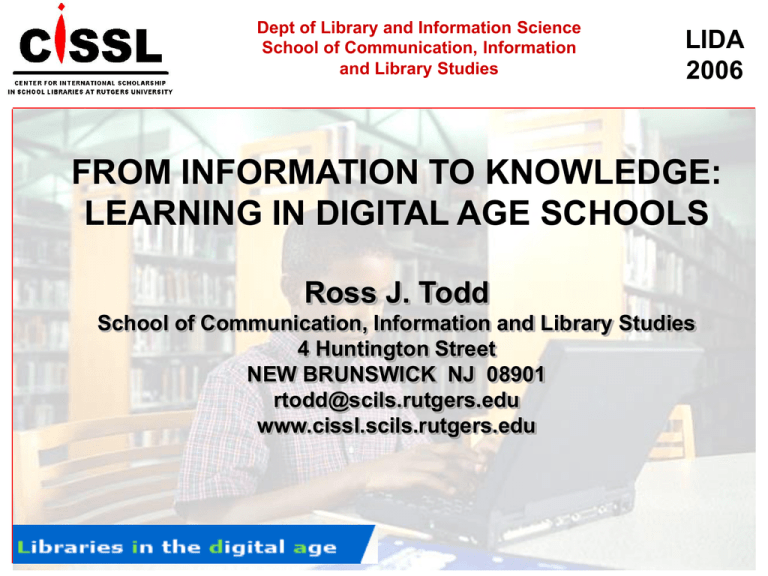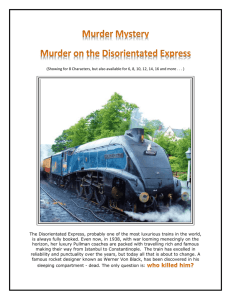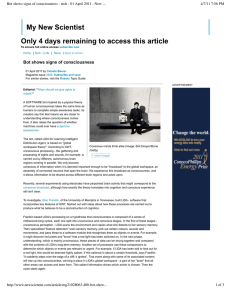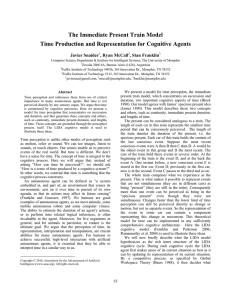From Information to Knowledge: Learning in Digital Age Schools
advertisement

Dept of Library and Information Science School of Communication, Information and Library Studies LIDA 2006 FROM INFORMATION TO KNOWLEDGE: LEARNING IN DIGITAL AGE SCHOOLS Ross J. Todd School of Communication, Information and Library Studies 4 Huntington Street NEW BRUNSWICK NJ 08901 rtodd@scils.rutgers.edu www.cissl.scils.rutgers.edu The Key Challenge LIDA 2006 • Are the early promises of information technology being realized?: “motivate and stimulate learning”, “motivate students to try out new ideas and to take risks”, “encourage analytical and divergent thinking” • Edward Tenner: NY Times article Searching for Dummies: “It would be a shame if brilliant technology were to end up threatening the kind of intellect that produced it”. • Do students learn anything in this Googlized world? • How can instruction and meaningful learning be enabled in the context of large and complex print and digital information environments in schools? • http://www.nytimes.com/2006/03/26/opinion/26tenner.html?ex=1146715200 &en=888eb440513e968c&ei=5070 How School Libraries Help Students LIDA 2006 • Student learning through Ohio School Libraries (Todd & Kuhlthau, 2004) - 13,123 students, 900 faculty. • Student learning through Australian School Libraries (Hay, 2005) - 6,718 students, 620 faculty. • Student learning through Delaware School Libraries (Todd 2006) - 5,733 students, 468 faculty. • 48 / 50 statements of “help”; + open ended critical incident question 7 Constructs of “help” 1. How helpful the school library is with getting information you need 2. How helpful the school library is in relation to information literacy skills 3. How helpful the school library is with your school work in general (knowledge building, knowledge outcomes) 4. How helpful the school library is with using computers in the library, at school, and at home 5. How helpful the school library is to you with your general reading interests 6. How helpful the school library is to you when you are not at school (independent learning & social world) 7. General school aspects –Academic Achievement LIDA 2006 COMPARISON OF FINDINGS (Delaware) BLOCK RANK OF MEAN FROM HIGHEST TO LOWEST LIDA 2006 Faculty Mean Student Mean 4 COMPUTERS 4.29 3.69 1 GETTING INFORMATION 4.27 3.6 2 USING INFORMATION - IL 3.94 3.41 3 KNOWLEDGE 3.92 3.38 5 READING 4.09 3.29 7 ACHIEVEMENT 3.79 3.22 6 INDEPENDENT LEARNING 3.49 3.13 Using Computers (Delaware) LIDA 2006 4. How helpful the school library is with using computers in the library, at school, and at home. Most helpful % Quite helpful % Some help % A little help % No help % 1. Computers in the school library help me do my school work better 47.8 21.9 9.6 9.6 8.2 2. The school library has gotten me more interested in computers 32.0 21.6 15.7 14.9 15.8 3. Computers help me find information inside and outside of the school library 51.2 21.9 12.6 8.4 6.0 4. The school library has helped me search the Internet better 37.0 22.9 15.3 13.5 11.3 5. The school library has helped me be more careful about information I find on the Internet 32.6 24.5 16.3 14.2 12.4 6. Computer programs (like Powerpoint, Word) in the school library help me do my school work 43.6 22.1 13.4 10.5 10.5 7. The school library has helped me feel better about using computers to do my school work 36.0 23.2 14.9 13.4 12.6 “Help” of Information Technology LIDA 2006 • Functional, in terms of providing access to and delivery of essential information resources; • Technical, enabling the students to develop a range of technical competencies, such as search skills; • Evaluative, enabling students to identify and evaluate accurate and authoritative information amid a real-world information environment that is complex, diverse, conflicting, and of variable quality; • Constructive, providing technical tools for the students to construct and present representations of their new knowledge and understanding of their researched topics Some Challenges for Digital Libraries & Schools But do they learn anything? Do we need libraries? How do we create an integrated information landscape? LIDA 2006 New Jersey IMLS Funded Research 2003 - 2005 LIDA 2006 • What learning outcomes does the school library enable as students make use of diverse digital and print information sources? • How might these learning outcomes be identified, measured, and embedded into professional practice? • Develop a learning impacts measure for use by school-based teams. (SLIM Toolkit: School Library Impact Measure) Central Research Questions LIDA 2006 • What changes, if any, are evident in students’ knowledge of a curriculum topic, as they proceed through the stages of a collaborative inquiry project, and make use of diverse print and digital sources? • What changes, if any, are shown in the students’ feelings as they proceed through the stages of a collaborative inquiry project? • How does the students’ study approach influence knowledge construction of a curriculum topic in collaborative inquiry projects? • What interactions exist between knowledge construction, feelings, and study approach, and what are some of the explanations for these interactions? Schools Context LIDA 2006 • 10 New Jersey public schools chosen by call for nomination and selected by NJ Expert Panel • Experienced and expert school librarians • Diverse schools • 10 teacher-school librarian teams • 10 school librarians working on curriculum projects with 17 classroom teachers • 574 students in Grades 6 – 12; range of disciplines • Data collected over four weeks, Spring 2004 • Inquiry Training Institute Feb 24, 2004: overview and critique of units, use of data collection instruments, procedures and ethical guidelines Data Collection Instruments LIDA 2006 Five data collection instruments were used to collect the data from the students: 1. 2. 3. 4. 5. Writing Task 1 (at initiation of inquiry unit) Writing Task 2 (at midpoint of inquiry unit) Writing Task 3 (at conclusion of inquiry unit) Search Journal Log Research Style The instruments consisted of a combination of qualitative and quantitative questions. Writing Tasks 1. 2. 3. 4. 5. 6. 7. 8. LIDA 2006 Write the title that best describes your research project at this time. Take some time to think about your research topic. Now write down what you know about this topic. What interests you about this topic? How much do you know about this topic? Check () one box that best matches how much you know. Nothing, Not much, Some, Quite a bit and A great deal Write down what you think is EASY about researching your topic. Write down what you think is DIFFICULT about researching your topic. Write down how you are FEELING now about your project. Check () only the boxes that apply to you. Confident, Disappointed, Relieved, Frustrated, Confused, Optimistic, Uncertain, Satisfied, Anxious or Other. How did School Librarian and Teacher help you (WT3) Changes in Knowledge: 5 Approaches to Measurement LIDA 2006 • Substance of knowledge. Analysis of changes in the relational nature of statements by which students described their topical knowledge. • Amount of knowledge. Numerical count of number of statements they used to describe their topical knowledge, as well as isolated concepts / terms. • Structure of knowledge. Thematic organization and integration of themes into a meaningful structure • Estimate of knowledge. Personal estimate of extent of their topical knowledge • Labeling of knowledge. The students were asked to give a title for their inquiry project, which was considered to reflect the degree of focus/specification of topical knowledge. Substance of knowledge LIDA 2006 Classification of Statements: based on nature of relationships between concepts Graesser & Clark (1985) Structures and procedures of implicit knowledge. Norwood, N.J.: Ablex. • Properties: • Manner: • Reason: • Outcome: • Causality: leads • Set Membership: • Implication: • Value judgment: statements describing characteristics statements describing processes, styles, actions statements of explanations of how and why statements providing end result statements showing some event causally to another statements about class inclusion statements showing predictive relations, inference, implied meaning statements presenting personal position or viewpoint Classification of Statements • • • • Properties: Manner: Reason: Outcome: • Causality: • Set Membership: • Implication: • Value judgment: LIDA 2006 The color of Valentine’s day is red People drive aggressively in USA The wall was constructed to block invaders (People eat too much) As a result, people got very sick Acid rain causes many fish to die Michelangelo created works such as statue of David, Cistine Chapel and the famous Pieta He was suspected of poisoning him That’s not right FACTS: property, manner, set membership EXPLANATION AND RESULTS: Reason, outcome, causality SYNTHESIS: conclusions, positions, viewpoints Affective Dimensions LIDA 2006 • Constructivist view of knowledge change posits feelings as an important aspect of information seeking and sustained integrated learning. • 9 feelings: confidence, disappointment, relief, frustration, confusion, optimism, uncertainty, satisfaction, and anxiety, were tracked at three stages of the inquiry unit (Kuhlthau). • Measured by asking the students to mark how they experienced a particular feeling on a 4-point scale from: very, fairly, a little to not at all. Approaches to Study (Entwistle & Tait, 1996; Heinstrom 2002) LIDA 2006 • Short version of the Approaches and Study Skills Inventory for Students (ASSIST) (Tait, Entwistle, & McCune, 1998), and adapted by Heinstrom for use with younger students. • Deep approach: characterized by students wanting to find out the deeper meaning in the text. They are critical, logical and relate what they learn to their previous knowledge • Surface approach: students concentrate on memorizing lots of facts without any effort to find a deeper meaning or understanding of the material • Strategic approach: students are efficient at organizing their work, managing their time and work hard in their studies. They care about their working conditions and have clear goals for their studies • Measured by six test items on a four-point scale total of 18 statements. Search Logs LIDA 2006 Students were asked to make an entry each time they read some information that they have found related to their topic. 1. Date 2. Where did you look for this information? (School library catalog/OPAC, Online, database, Print index, Search engine, Public library, Asked a person, Website, Other -Choose one of the above and write down its number.) 3. List all the terms (word or phrases) you used to look for this information. (These are the words you put into the school library catalog, or a search engine on the WWW, look up an index, or ask a person.) 4. Give the details of the source of your information (Sources can be books, journal articles, magazines, websites, CD-Rom and people such as teacher, librarian or others). Write the author, title, and date; or name of person Total Number of Statements Recorded at Each Stage Statement Type LIDA 2006 WT1 N WT2 N WT3 N Number of statements Number of statements Number of statements Properties 1194 1820 2160 Manner 589 1190 1514 Set membership 143 218 343 Number of statements Number of statements Number of statements Reason 152 163 193 Outcome 35 58 89 Causality/consequence 48 105 116 Synthesis 29 70 82 Facts Explanation and result Changes in Knowledge LIDA 2006 • Students represented their knowledge of the topic predominantly by factual property and manner statements, and that they used increasingly more factual statements to represent their knowledge throughout the three stages. • Overall the number of reason and outcome statements was lower than property and manner statements, and did not substantially increase as students progressed, while the cause/consequence and synthesis statements show a decreasing though non-significant trend. • Students appeared to be oriented to gathering facts and knowing a set of facts throughout their inquiry. • Two distinctive approaches to knowledge construction: Additive and Integrative ADDITIVE APPROACH LIDA 2006 • Knowledge development seemed to be characterized by the progressive addition of facts • Remained on a descriptive level throughout. • Addition of new facts was typically a listing of property statements of a generic, superficial kind. • As the students built knowledge, they continued to add property and manner statements, and to a lesser extent, set membership statements. • Students typically found more facts at each stage of the research process, and added these to their stockpile of facts, even though these added facts were sorted, organized and grouped to some extent into thematic units by WT3. ADDITIVE APPROACH LIDA 2006 WT1: He is very famous for his plays …….(100, 285001) WT2: He married Anne Hathaway. They had 3 children. ……He wrote 37 plays and 152 sonets. …… (100, 285001) WT3: He was born on April 23, 1564 in Warichshire, Stratford-upon-Avon, Britain………Married at age 18. Had three children; Judith, Hammet and Susana. He was the first boy in the family, had 3 sister and 1 brother, Joan, Margaret, Gilbert sibling.(100, 285001) INTEGRATIVE APPROACH LIDA 2006 • Some students moved beyond gathering facts at each stage, rather they manipulated these facts in a number of ways: - building explanations - synthesizing facts into more abstract groupings and consequently reducing the number of statements in their representations - organizing facts in more coherent ways - reflecting on facts to build positional, predictive conclusion statements. • At WT1, their representations were similar to the additive model, with sets of facts statements. However, at WT2, their representations included more facts, as well as explanations. • At WT3 they appeared to interpret the found information to establish personal conclusions and reflect on these. In addition, some appeared to subsume sets of facts into more abstract groups. Immune reactions LIDA 2006 WT1: It probably has most to do with how the body reacts to certain problems in the body. Like how a body reacts to a sneeze or a cough. WT2: The immune system is what protects you, anybody, from various outside bacterias, viruses, and germs. …….The immune has I-cells and other types of cells that help fight the……When you cut yourself you can see the immune system at work because you can see the cells that are rebuilding the tissues that were cut………(long reply) WT3: (very long reply) The immune system was a big topic. I found out that there is actually two types of immune systems in the body. ………I learned that if a bacteria enter your body, it could enter a cell, replicate in a manner of minutes and if there are…..So you could have millions of bacteria in the body after an hour…….the body works against such organ degration, mineral deficiency, mechanical damage and other. What I really enjoy to learn was that the minute you are born….and when you die your immune system shuts down letting in all the bad stuff, so now the body is an open door…. Coding of Structure of Knowledge Ideas are discrete and unrelated. Some –meaning more than one instantiation- some ideas are joined or linked (grouped) while others are discrete or unrelated. Contiguous ideas are associated; set of ideas may be somewhat continuous. Overall, ideas are interrelated and continuous. Ideas are integrated and unified; there is structural centrality. LIDA 2006 Structure and Level of Knowledge LIDA 2006 • Typical change was from unstructured and random listing of facts (properties, manner and set member lists) towards organization of facts into thematic groupings, with a smaller number of students linking the thematic groupings into larger more coherent and more conceptual units. • For some students, particularly those showing an additive model, WT1 showed more structure than WT2. This is consistent with the pervasive viewpoint that people’s existing knowledge is structured. • Gathering of facts rather than sequencing and organizing these facts seemed to take over, as evident in WT2 representations being less structured. By WT3, some organization of statements into conceptually coherent and linked groups had taken place. We also found a higher level of structure at WT1 for those students who indicated from the start that they knew something about their topic. LIDA 2006 Estimate of Knowledge How much do you know about this topic? WT 1 n WT 2 n WT 3 n Nothing 35 (10 %) 6 (2%) 1 (.3 %) Not much 142 (40%) 14 (4 %) 6 (2 %) Some 125 (35 %) 111 (33 %) 29 (9 %) Quite a bit 41 (12 %) 156 (47 %) 148 (48 %) A great deal 10 (3 %) 47 (14 %) 126 (41 %) Knowledge increase (mean) 1.26 (.91) 2.6 (.83) 3.2 (.76) Perceptions of Knowledge Gained LIDA 2006 • Not much more • Know “heaps” more • Know lots more, and surprised at breadth and depth of knowledge • Know lots more, but still could learn more • Know lots, but dissatisfaction about not knowing enough Approach to studying • The three study approaches were quite evenly distributed within the sample as a whole. • Study approaches were only explored in relation to other aspects of the inquiry project. LIDA 2006 The influence of approach to studying: Deep learners LIDA 2006 • Typically deep students demonstrated their knowledge change by synthesized replies • They were confident and optimistic throughout the process. • Seemed more relieved and satisfied at the end than students on average. • Conveyed a specific interest for their topics, and interest was a key basis for in learning more about the topic • Eagerness to learn -> run the risk of becoming particularly vulnerable to information overload • Strong awareness of information quality. Students with the most surface study approach LIDA 2006 • Knowledge seemed to remain on a rather factual level throughout their projects. • Estimates of knowledge did not change as much as on average. • Little increase in level of their topical knowledge. • The aspect of the search process that these students predominantly mentioned as easy was availability of information. • Information seeking foremost is seen as a process of collecting facts. • Seemed particularly relieved when the projects ended. • Low levels of interest and engagement. Students with the most strategic study approach LIDA 2006 • Similar to deep, increased their topical knowledge regarding content, amount. • Driven by achievement rather than inherent interest to learn more about the topic. • When asked to state what they had learned through their projects the strategic students described their topics, rather than reflecting on them as the deep ones did, also mentioned that they had developed their skills in organizing their work, and managing their time. • The strategic students felt confident throughout the inquiry projects. They also experienced satisfaction and relief at the end of the projects. What learnings took place? LIDA 2006 • Increase in knowledge about a topic • Skills in using specific online sources (online databases, Internet, OPACs) • For some, development of research skills, especially “combining” information (viewed as highly important) • Widened information horizon and changed conceptions of information seeking – “The Transformed Googlians” – recognition of beneficial information sources beyond Google • More realistic conceptions of efficient information seeking • Heightened awareness of quality aspects of information • Dealing with information conflict Factors contributing to differences across Schools LIDA 2006 • Yes there were variations in the schools • Changes in knowledge (knowledge growth) did not occur evenly in the schools • No significant variations across the age, grade, and gender groups; the disciplinary field does not seem to be an explanatory factor • Nature of task: imposed task or negotiated task • Engagement and ownership • Nature of Interventions: Development of skills to construct knowledge rather than finding information So What? LIDA 2006 • What constitutes the development of deep knowledge? Deep understanding? • How can IT be more effectively harnessed to foster the development of deep knowledge and deep understanding? • What instructional interventions help students move from the “transport” of text to the “transformation” of text? • How do we guide students in the process of their inquiry? GUIDED INQUIRY • What is the nature of the intervention in terms of intellectual and affective scaffolds for enabling inquiry? • How do we enable students to stay focused and not be detracted from the learning task at hand? • How do we motivate and engage students who may perceive task of searching as primarily one of gathering information to a task of forming a focused perspective from the information encountered?




